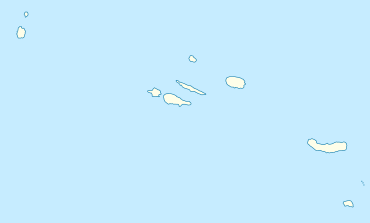Santa Maria Airport (Azores)
| Santa Maria Airport Aeroporto de Santa Maria | |||||||||||
|---|---|---|---|---|---|---|---|---|---|---|---|
.jpg) | |||||||||||
| IATA: SMA – ICAO: LPAZ | |||||||||||
| Summary | |||||||||||
| Airport type | Public | ||||||||||
| Owner | Government of Portugal | ||||||||||
| Operator | ANA Aeroportos de Portugal | ||||||||||
| Serves | Vila do Porto | ||||||||||
| Location | Santa Maria Island, Azores | ||||||||||
| Elevation AMSL | 94 m / 308 ft | ||||||||||
| Coordinates | 36°58′26″N 025°10′16″W / 36.97389°N 25.17111°WCoordinates: 36°58′26″N 025°10′16″W / 36.97389°N 25.17111°W | ||||||||||
| Map | |||||||||||
 LPAZ Location in the Azores | |||||||||||
| Runways | |||||||||||
| |||||||||||
| Statistics (2011) | |||||||||||
| |||||||||||
Santa Maria Airport (IATA: SMA, ICAO: LPAZ) is an airport located 5 km (3.1 mi) west northwest of the urbanized area of Vila do Porto on the Portuguese island of Santa Maria, in the autonomous region of the Azores. A principal hub to transatlantic travel in the past, following the Second World War, the airport slowly took more of a regional role, while still maintaining communication duties within the European airspace corridor.
It has one runway which is 3,048 m × 60 m (10,000 ft × 197 ft). The airport is classified as an adequate ETOPS alternate, having suitable facilities to accommodate transatlantic flights needing to make an emergency landing.
History
.jpg)
It was built in the context of the Second World War, by US troops in order to maintain supply lines to Europe, and inaugurated on 26 July 1945. A year later, on 2 June 1946, American forces transferred title/control to the Portuguese State.
The airport at Santa Maria was part of a larger complex of buildings and infrastructures constructed in the 20th century.[2] Apart of the airport terminals and ground control facilities, the area later known as Aeroporto locally, included a residential barrio, the services and equipment to support local residences, roadways and many of first signals, public transport stops and electrical transformer stations.[2] The development of this district was important in the development of the island, with many of the installations left by American troops after the Second World War (the early terminal, control tower, building of Clube Asas do Atlântico, gymnasium, cinemas and warehouses) and many of the semi-cylindrical troop-quarters retained after the withdraw of forces.[2] Its North American influence and original purpose marks its differences to local construction; the urban design and buildings, just like many of the projected constructions by architect Keil do Amaral (the airport, residence of airport director, groups of residences and signalling) make the district distinct from the other areas of the island.[2] The newer neighborhoods and recent buildings, are of an inferior architectural quality, and correspond to the blocks closer to the airport.[2]
The forerunner of SATA Air Açores (Sociedade Açoriana de Transportes Aéreos) initiated services concurrently to São Miguel and Terceira from Santa Maria Airport on 5 August 1947, using a plane christened "Açor".
Transportes Aéreos Portugueses (TAP) began lay-over flights to this airport on 7 December 1962, eventually inaugurating trans-Atlantic service between Santa Maria-New York (26 April 1969) and Santa Maria-Montreal (8 May 1971).
For a while, Air France's supersonic Concordes were routed to Santa Maria on refueling layovers between Paris and Caracas.
Along with the airports in Lisbon, Porto, Faro, Flores, Horta, Ponta Delgada and Beja, the airport's concessions to provide support to civil aviation was conceded to ANA Aeroportos de Portugal on 18 December 1998, under provisions of decree 404/98.[3] With this concession, ANA was also provided to the planning, development and construction of future infrastructures.[3]
Airlines and destinations
| Airlines | Destinations |
|---|---|
| SATA Air Açores | Ponta Delgada |
| SATA International | Lisbon |
Accidents and incidents
- A chartered Boeing 707-300 (N7231T), Independent Air Flight 1851 from Bergamo, Italy in 1989 crashed on approach to Santa Maria Airport, when it struck the Pico Alto mountain. The aircraft was destroyed with the loss of all passengers (137) and crew (7). The accident was the result of bad communication and failure to follow standard procedures by crew and air traffic control.[4]
See also
References
- Notes
- ↑ AIP Part 3 – AD 2 Aerodromes
- ↑ 2.0 2.1 2.2 2.3 2.4 Aeroporto de Santa Maria (in Portuguese), SREC/DRAC, 22 November 1994
- ↑ 3.0 3.1 ANA Aeroportos: Relatório de Gestão e Contas (2011) (PDF), Lisbon, Portugal: ANA Aeroportos de Portugal, SA, 2011, p. 1115, retrieved 2 January 2014
- ↑ N7231T at the Aviation Safety Network
- Sources
- Oliveira, João Eduardo Franco de (1996), Aeroporto de Santa Maria. 1946–1996 (in Portuguese), Aeroportos e Navegação Aérea, ANA
External links
![]() Media related to Santa Maria Airport (Azores) at Wikimedia Commons
Media related to Santa Maria Airport (Azores) at Wikimedia Commons
| ||||||||||||||